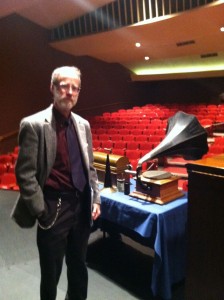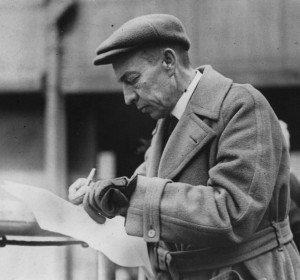Stanford University’s music department became an oasis in academia when it hosted a third symposium on historic recordings (April 12-14, 2012), covering what obsesses many of us and playfully dominates our lives and actions: reacting to discs that lure one by their staggering expressivity and culture, draped in the flirtatious je ne sais quoi of an authenticity, either a miracle or mirage. So we all landed and began to play and discuss traces of this elusive element.

I always begin a new music class by dragging them inside the sound world. Imagine taking an Art History course where your professor hands out black and white photocopies of great artworks bearing numbers on their visual components. You are advised to look at an inset that defines the numbers as colors and told that it’s all here, no need to schlep to a museum and bother with the original. Music too often gets taught this way, as many seek to avoid studying and listening to recordings, especially from long ago, as forgotten masters are deemed to be out of style, even by people who never heard their playing. Better restoration has changed the torture of bacon frying into a living sound.
So in the face of this challenge to music, it’s a sizzling soothing scene to find international like-minded profs assembled by George Barth and Kumaran Arul who both contributed to and provided a forum for ideas and approaches. One case surrounded an attempt to rescue Scriabin’s music.
A visionary, he imagined that global transformation would be realized through a performance of his final but incomplete Mysterium, meant to be simultaneously unfolded throughout the world, including Tibet. When I met Kyriena Siloti, Rachmaninoff’s cousin, she recalled visiting Tibetan lamas in St. Petersburg before the Revolution and how their breathing exercises helped her tackle the rough climate while fleeing the Bolsheviks, stuck in Yekaterinberg where the Romanoff’s were murdered, heading to Harbin, China. Scriabin also tapped into what we now consider our newly found alternative life styles, getting inside this wildness over a century ago.
As much as Scriabin gazed ahead, he avoided crucial contact with the recording horn. We will never hear how his piano sounded. Kyriena and two other ladies from her time all concurred that Scriabin’s playing was inimitable in its nuances, sfumature as the Italian-speaking Maria Safonoff would say. Maria had lived in Varese, Italy for nearly a year after fleeing the Revolution yet sixty years in New York didn’t help her master English. All singled out Vladimir Sofronitsky as one closest to the composer’s own playing, albeit having more strength in his dynamics.
Scriabin allowed himself to play on an instrument punching holes in a paper roll to capture the exact notes and their spaces, playable on a mechanical piano. He left many works in this state, lacking contrasts in touch, balance, degrees of soft/loud, but one can isolate details and step a little closer to how he may have played in a way that departs from his own notation. One remarkable investigator, Anatole Leikin, a professor at UC Santa Cruz, sat down to play Scriabin’s Désir, using the piano roll as a base for recreating parts of the composer’s lost art. Leikin recorded a generous and intriguing CD of reconstructed Scriabin. Hear the Etude, op. 42, no. 5, one usually projected as a wild virtuosic foray. Leikin summons it forth as internal sonic magma:
Scriabin Etude op. 42, no.5 by Anatole Leikin
A thorny Scriabin assessment came later via a grad student who appropriated Scriabin’s own piano roll of an early Prelude into software that logged rhythmic irregularities, creating printed data of all his shifts, coloring notes to show speeding up or being slowed, and how the composer altered them from straight-forward into swing rhythms.
But what is one to do with data? I asked if analyzing the music would better explain the motives behind internal and structural changes. One needs to use ear and eye to fathom underlying reasons, and they emerge without troubling oneself over taking, let’s say, the following three notes 2% faster. Why is more important than How and When. I mentioned this approach of graphing music to Miriam Kartch, a pianist at Mannes College who first arrived there in 1941 and studied with pupils of Schenker. Waking her with an early morning phone call, she huffed in alarm: “That’s not music. It’s autism!”
I was asked at the symposium if Vladimir Sofronitsky had ever heard Scriabin play.
Somewhere in print you find that he did not experience this rare encounter. Many pore over his work in writing, like viewing a house from outside. I like to walk in before anything else starts up. Over the years I had been in touch with Sofronitsky’s daughter Roxanne, seen here with her son Alexei, who resembles his great-grandfather, snapped in their California home during a symposium break:
Sofronitsky held a ticket to Scriabin’s 1915 solo piano recital in Moscow. They mentioned that the fourteen-year-old had a high fever that evening and was forcibly kept home by his parents amidst his incessant protests. Days later, Scriabin developed a pimple on his lip which led to septicemia and sudden death. A photo of the composer hung over Sofronitsky’s piano, and he married the composer’s daughter Elena, whom I met in 1987 (at home in Moscow) and 1988 (in California, her first and only USA trip):

Scriabin’s death was shocking, leaving a void in music and depriving us of a striking dimension that he was eagerly exploring. Elena hardly new her father as her parents divorced early on. Rachmaninoff gave a memorial concert in Moscow.
Several attendees told me that while they appreciated Rachmaninoff’s gesture, he lacked a grasp of Scriabin’s style. This is evident on his one surviving example, playing Scriabin’s Prelude, op. 11, no. 8 in a way that shapes the music into a Chopinesque melody with a focus on the right hand. The left hand has an equally important part and Rachmaninoff coolly doesn’t grasp its proportioning and role, a rare lapse of judgment:
Sofronitsky creates a fuller perspective by having both hands intertwining their parts, probing its essence, summoning elements of the composer’s unknown playing:
It’s delightful to hear scholars agree and expound on your preferences but you learn absolutely nothing from this pleasure. However those who assault you with unexpected successes and glaring misjudgments end up providing a greater favor as catalysts to thought. This symposium veered into a Trimalcionian banquet (here in Fellini’s interpretation of Petronius) spanning the enlightened and the bizarre.
I leave you a way to lose yourself in the subtleties and suggestiveness of Scriabin’s Fragilité
as played by Samuil Feinberg, who knew its composer and received his approval.






This is like lifting the veil from my ears. Just because someone lived before modern technology does not make them less intelligent or sophisticated than we are. To compare art and creativity unfavorably with modern technology keeps us from discovering our heritage.